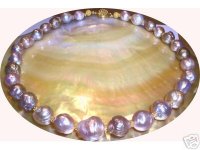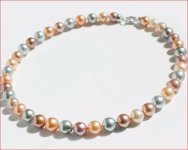Caitlin
Well-known member
- Joined
- Dec 11, 2004
- Messages
- 8,502
I searched for the words Kasumi and Kasumiga on this forum before I started this thread- couldn't find anything so here goes what i have found out. Kenji-please comment!
Kasumiga pearls are from a lake in Japan by the same name. They are freshwater pearls that areproduced by a hybrid clam. Please go to this link for a description http://www.imperial-deltah.com/news2/kasumiga_pearls.htm
a really fascinating thing about these pearls besides their huge size and beauty is that they are nucleated with thinly nacred akoya pearls! That is, clam shell beads were put into the akoya as usual, then when they were removed they were actually drillled, then rejected for sale I presume, then put into the freshwater mussel!
(Remember, I asked in another post if fw pearls could be used to nucleate Akoyas to produce a solid nacre akoya. Apparently not, but here is the opposite. I believe the company is disclosing this now, if not before, and I think it is probably the best way to get pearls so large.)
http://www.gia.edu/newsroom/issue/2798/983/insider_newsletter_details.cfm#3
(this is a quote of the online summary by the GIA)
Gem News contributing editor Dr. Henry Hanni of the SSEF Swiss Gemmological Institute, recently examined some attractive Japanese freshwater cultured pearls called Kasumiga after the pearl-culturing region of Lake Kasumiga, north of Tokyo. The three 40-cm-long strands consisted of approximately 40 pearls each, with diameters ranging from 9 to 13 mm. X-radiographs revealed the presence of two drill holes in each pearl at a random orientation to each other. Gems & Gemology previously reported such features in Japanese freshwater cultured pearls nearly 40 years ago (see R. Crowningshield, "Fresh-water cultured pearls," Spring 1962, pp. 259-273).
With the client's permission, half of one cultured pearl was ground away and the surface polished. The bead nucleus was covered by a very thin (0.2 mm) overgrowth of nacre, which was separated by a slight gap from a much thicker (>2 mm) layer of freshwater nacre. An energy-dispersive X-ray fluorescence analysis of the pearl's surface showed an abundance of manganese, thereby confirming the freshwater origin of the outer nacre layer. It appears, then, that drilled low-grade Akoya (saltwater) cultured pearls were used as bead material for these Kasumiga freshwater cultured pearls, which are said to be grown in a Hyriopsis schlegeli x Anadonta plicata hybrid mussel. The result is freshwater cultured pearls of remarkable diameter with thick nacre layers and appealing surface quality.
More information and photos of these Kasumiga cultured pearls will appear in the upcoming Summer 2000 issue of Gems & Gemology.
To reserve your copy, or to subscribe, contact the Subscriptions Manager, Debbie Ortiz [mailto:dortiz@gia.edu], or call toll-free 800-421-7250 ext. 7142. Outside the US and Canada, call 760-603-4000 ext. 7142. Visit G&G online.
Here is a link to a strand being sold on ebay. I emailed the seller and asked permission to post the actual picture here as well.
http://cgi.ebay.com/ws/eBayISAPI.dll?ViewItem&category=3844&item=4954964372&rd=1
Kasumiga pearls are from a lake in Japan by the same name. They are freshwater pearls that areproduced by a hybrid clam. Please go to this link for a description http://www.imperial-deltah.com/news2/kasumiga_pearls.htm
a really fascinating thing about these pearls besides their huge size and beauty is that they are nucleated with thinly nacred akoya pearls! That is, clam shell beads were put into the akoya as usual, then when they were removed they were actually drillled, then rejected for sale I presume, then put into the freshwater mussel!
(Remember, I asked in another post if fw pearls could be used to nucleate Akoyas to produce a solid nacre akoya. Apparently not, but here is the opposite. I believe the company is disclosing this now, if not before, and I think it is probably the best way to get pearls so large.)
http://www.gia.edu/newsroom/issue/2798/983/insider_newsletter_details.cfm#3
(this is a quote of the online summary by the GIA)
Gem News contributing editor Dr. Henry Hanni of the SSEF Swiss Gemmological Institute, recently examined some attractive Japanese freshwater cultured pearls called Kasumiga after the pearl-culturing region of Lake Kasumiga, north of Tokyo. The three 40-cm-long strands consisted of approximately 40 pearls each, with diameters ranging from 9 to 13 mm. X-radiographs revealed the presence of two drill holes in each pearl at a random orientation to each other. Gems & Gemology previously reported such features in Japanese freshwater cultured pearls nearly 40 years ago (see R. Crowningshield, "Fresh-water cultured pearls," Spring 1962, pp. 259-273).
With the client's permission, half of one cultured pearl was ground away and the surface polished. The bead nucleus was covered by a very thin (0.2 mm) overgrowth of nacre, which was separated by a slight gap from a much thicker (>2 mm) layer of freshwater nacre. An energy-dispersive X-ray fluorescence analysis of the pearl's surface showed an abundance of manganese, thereby confirming the freshwater origin of the outer nacre layer. It appears, then, that drilled low-grade Akoya (saltwater) cultured pearls were used as bead material for these Kasumiga freshwater cultured pearls, which are said to be grown in a Hyriopsis schlegeli x Anadonta plicata hybrid mussel. The result is freshwater cultured pearls of remarkable diameter with thick nacre layers and appealing surface quality.
More information and photos of these Kasumiga cultured pearls will appear in the upcoming Summer 2000 issue of Gems & Gemology.
To reserve your copy, or to subscribe, contact the Subscriptions Manager, Debbie Ortiz [mailto:dortiz@gia.edu], or call toll-free 800-421-7250 ext. 7142. Outside the US and Canada, call 760-603-4000 ext. 7142. Visit G&G online.
Here is a link to a strand being sold on ebay. I emailed the seller and asked permission to post the actual picture here as well.
http://cgi.ebay.com/ws/eBayISAPI.dll?ViewItem&category=3844&item=4954964372&rd=1


